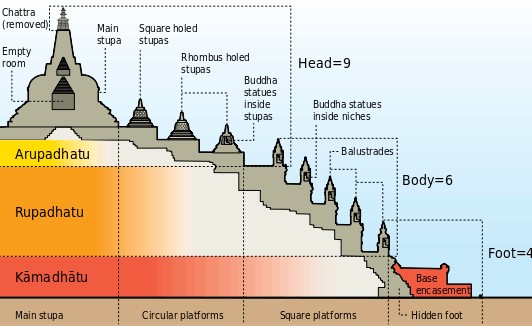
We saw that ancient Hebrew scriptures record how cravings (Tanha) and wrong thoughts (Kleshas) arose at the beginning of history. But what about the suffering, pain or unhappiness, known as Duhkha/Duhkka? Duhkha and Tanha form the basis of the Four Noble Truths articulated by Gautama Buddha.
Similarly, what about Impermanence, called anicca (Pāli) or anitya (Sanskrit)? This insight of anicca asserts that all existence is transient, ephemeral, and inconstant. All things, whether material or mental, are compounds in a continuous condition of change, subject to decline and destruction. They come into being and eventually dissolve.
Do the ancient Hebrew Scriptures explain how anicca or impermanence arose?
We saw that the Adversary (the Devil or Mara) to the Creator God led the first humans into disobedience. Mankind had been created in the Image of God, but that image was now marred with wrong thinking and cravings. The Creator God then responded both to His Adversary and also to mankind. We look at His response to His Adversary later. Here we see how He established samsara for the physical universe, the concrete realm of forms or Rupaloka (Rūpadhātu).
The Samsara Cycle of the Universe – And Everything in It
The Creator first confronted the earliest humans, exposing their disobedience. Then He instituted another principle into the world – that of suffering (duhkha), impermanence (anicca) and death (Mrtyu). The Hebrew Scriptures record how the Creator God pronounced this.

Jan Brueghel, PD-US-expired, via Artnet
17 To Adam he said, “Because you listened to your wife and ate fruit from the tree about which I commanded you, ‘You must not eat from it,’
Genesis 3:17-19
“Cursed is the ground because of you;
through painful toil you will eat food from it all the days of your life.
18 It will produce thorns and thistles for you,
and you will eat the plants of the field.
19 By the sweat of your brow you will eat your food until you return to the ground,
since from it you were taken;
for dust you are and to dust you will return.”
All physical life (human, animal and plant) had been made from the chemical elements in the ground – the ‘dust’. So when the Creator God cursed ‘the ground’ He indirectly cursed all life developed from these elements of the ground. This affected the entire ecology, the cycle of systems which drive life. No longer would these cycles be in harmony. Instead, humans would experience life in ‘painful toil’. Nature would frustrate the work and efforts of man so that it would produce ‘thorns and thistles’ – pain. Ultimately, mankind’s fate would be to return to dust – death.
From now on impermanence, or annica, would characterize the elements of the cosmos. Since man was made from the chemical elements (carbon, hydrogen, oxygen etc.), he would experience suffering (duhkha) and impermanence. Through his mortal life feeling the steady encroachment of death through aging. Death was an inescapable fate for all living beings, be it a human, animal, or plant, without exception.
Suffering and Conflict in the Families
The Creator God also made a pronouncement affecting the relations between the male and female.
16 To the woman he said,
Genesis 3:16
“I will greatly increase your pains in childbearing;
with pain you will give birth to children.
Your desire will be for your husband,
and he will rule over you.”

Originally created in the image of God as male and female, this unity would fracture. Instead, from now on there would be conflict and rivalry between them. The role of childbirth and raising of children would now be ‘painful’ rather than satisfying.
This article examines the Chinese script to see evidence that this event did occur in history.
Human history, throughout time and across all cultures, documents pain from an uncaring world, suffering in families, and illness, aging and death for all people. This reality is far too apparent. But why did the Creator respond with this curse to human kleshas (wrong thoughts) and Tanhas (attachments)?
Why the Principle of Duhkha and Death?
The ‘Tree of the Knowledge of Good and Evil’ did not impart knowing in the sense of simply understanding something. In the Devil’s temptation he said that in eating from that tree:
5 “…you will be like God, knowing good and evil.”
Genesis 3:5b
God does not ‘know’ good and evil in the sense of learning it like man might ‘know’ mathematics as he progressively learns more arithmetic, geometry, and algebra. God ‘knows’ good and evil in the sense of deciding what is good and what is evil. God’s knowing is in the deciding, not in the learning. We may learn the rules of arithmetic but we do not determine or decide what its rules will be. We simply learn them. In this manner, we cannot simply decide that 2 + 2 = 5, but rather we learn that 2 + 2 = 4. This is a mathematical truth that transcends us.
Up to this point, man and woman trusted God to determine what was good and what was not. The heart of the Devil’s temptation was that they cease trusting God to determine what was good and evil. Instead, like God himself, they would decide in their own essence what was to be good and what was to be evil. In taking that step they declared themselves independent from God. They were separating from His rule to establish their own. Man decided that he was a (little) god also.
Separation to Death
Thus man separated himself in spirit from his Creator. But this was the height of folly because his life source came from the Creator. A branch needs the tree root for sustenance and must therefore remain attached to the root for life. In the same way so also must man remain united with God. The foolish branch that cuts itself off from its root will soon wither and die. That is what happened when man disobeyed the command of God. Man, the foolish branch, cut himself off from the root, the source of his life.

In the ancient Hebrew Scriptures, death meant ‘separation’. We often think of death only in terms of the separation between soul and body when a person dies physically. In physical death, the person’s soul separates from the body and the person ‘dies’. It appears like the ‘person’ inhabiting the body has departed, leaving the body empty and ‘dead’. But death is not only the separation of soul and body.
The Hebrew Scriptures viewed death as more comprehensive than only that. Death also meant a spiritual separation between man and His Living Creator. The moment that man ate from the Tree of Knowledge of Good and Evil, to be ‘like God’, he died. He separated spiritually from His Creator. This separation showed itself in his shame, his hiding and his blaming. He was now enslaved to ignorant thoughts (kleshas) and cravings (Tanha).
Separation of Dhatus
We can also think of it in this way. Buddhist cosmology proposes that the spiritual plane of existence divides into three realms, or dhātus:
- the formless realm (Ārūpyadhātu), corresponding to the formless jhanas;
- the form realm (Rūpadhātu), corresponding to the rūpa jhānas; and
- the desire realm (Kamadhātu).
In the beginning, the formless or spirit realm was united with the physical or form realm. But when evil desire arose, God’s spirit realm (Ārūpyadhātu) separated from the form realm (Rūpadhātu) and so a spiritual death ensued. The man died spiritually that very day. Because of that, a physical death began.

Irul Oziq, CC BY-SA 4.0, via Wikimedia Commons
The Borobudur temple, the largest Buddhist temple in the world, is designed to mirror the three realms of Buddhist cosmology. Each realm can be seen highlighted by a respected colour, with the white in the center symbolizing Buddhahood. The diagram below depicts how the Borobudur temple reflects the journey one takes through the 3 realms.

Gunawan Kartapranata, CC BY-SA 3.0, via Wikimedia Commons

Gunawan Kartapranata, CC BY-SA 3.0, via Wikimedia Commons
Separation and Divorce
We can also use marriage and divorce as a lens to understand what happened. The Bible uses this metaphor to describe the relationship between the Creator God and mankind. When a partner in marriage files for divorce, the couple divides up their assets and then they live separate lives. When the first humans ate from the Tree they filed for divorce from their Creator.
But how to divide the assets?

Everything (light, energy, information) belonged to the Creator and mankind would retain only empty darkness as their sole assets in any divorce. To help them get just a little taste of what such a divorce would be like the Creator agreed to a separation. In this separation, mankind could taste just a little of what complete chaos and dissolution would be like. So God instituted this cycle of samsara with annica of ever-present and increasing disorder and decay. This would help us decide whether we wanted to return to the marriage before the separation became Permanent Divorce.
The Creator loved man and He planned to win back his love. Samsara would allow people to reevaluate their divorce plans. The Creator God planned to redeem back man, but man needed to feel and taste what existence apart from God’s Life was like. The world was changed for the worse so we could learn.
But our decision to disobey our Creator also changed us for the worse. The Bible portrays us as corrupted from our original image. As a patient needs to understand the negative diagnosis of a doctor regarding his medical condition, we need to understand our current condition. We do so next.